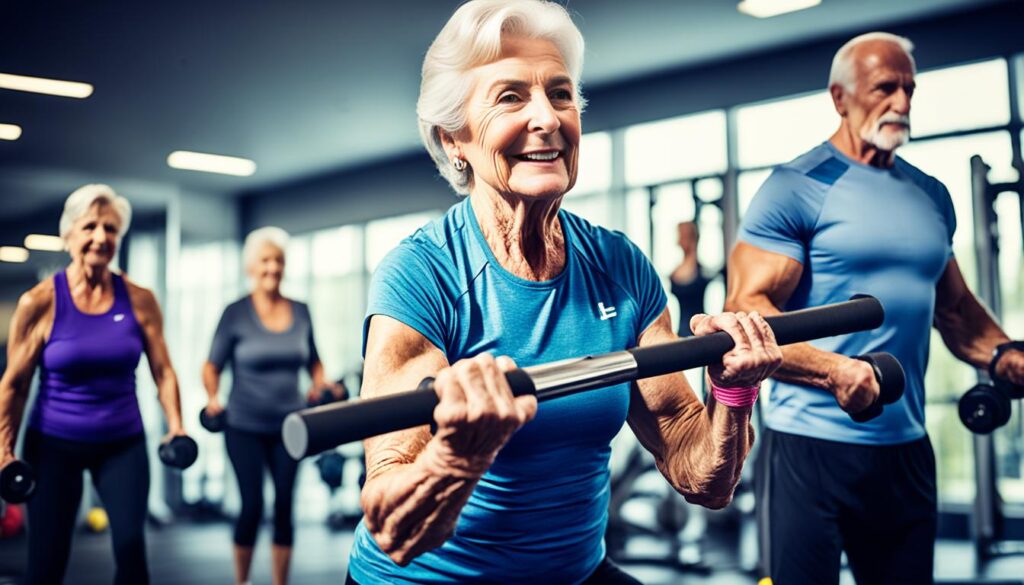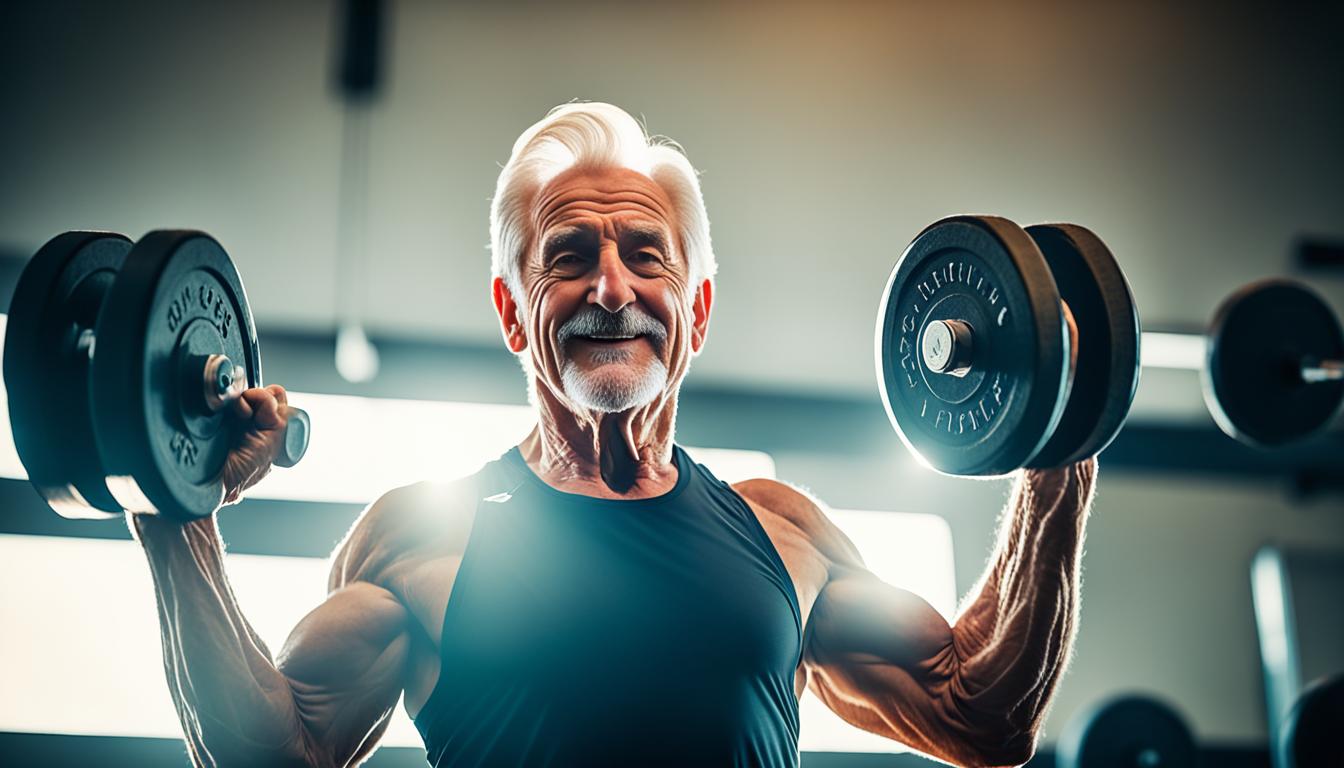Did you know after turning 30, adults could lose up to 3-5% of their muscle mass every ten years? This happens if they don’t stay active. That’s why strength training is key for older athletes, known as “Aginos.” It’s not just about getting stronger. Strength training boosts bone density, muscle mass, and joint flexibility. It’s essential for the health and longevity of seniors.
For aging athletes, strength training is not only about keeping fit. It’s about improving the quality of their lives. Science shows that regular, specific workouts have many benefits. These exercises fight off muscle loss and enhance mental health. Strength training helps aging athletes lead vibrant, active lives. This guide explores these advantages, offering insights for a better fitness journey.
Key Takeaways
- Strength training helps mitigate muscle loss associated with aging.
- Improves bone density, reducing the risk of fractures.
- Enhances joint flexibility and overall physical health.
- Boosts mental well-being and cognitive function.
- Supports longevity and a higher quality of life.
- Facilitates vibrant, activity-filled lifestyles for senior athletes.
The Importance of Strength Training for Aging Athletes
As we get older, it’s key to keep our muscles strong and our bodies functional. Strength training is essential for aging athletes. It fights off sarcopenia, which is the loss of muscle that happens naturally.
This kind of training helps older athletes stay independent and happy. Being active this way boosts their ability to do everyday things with ease.
Adding strength training to a workout routine helps prevent falls and injuries. This is especially important for aging athletes. It keeps them from getting hurt and lets them stay active.
Creating workouts that fit the unique needs of older athletes is key. It ensures they get the most benefit and stay safe, keeping them healthy for the long run.
One benefit for aging athletes is better functional performance and muscle strength. This is important for daily activities. Strength training also lets them keep enjoying their favorite sports and activities.
It supports both their physical and mental health. This approach helps maintain a great quality of life as they age.
Knowing about strength training’s benefits lets people make smart choices for their workout routines. This plan boosts their physical, mental, and emotional health. Strength training is a must for a balanced fitness plan for seniors.
Physical Benefits of Strength Training for Seniors
Strength training for seniors offers plenty of health perks. It helps them stay strong and lively. Through regular workouts, seniors can boost their muscle mass, bone strength, flexibility, and balance. These gains are crucial for keeping fit and healthy.

Increased Muscle Mass
Strength workouts are key for seniors to combat muscle loss that comes with age. Gaining muscle mass speeds up metabolism. This helps in burning calories efficiently. As a result, it aids in weight control and increases energy levels. So, seniors can enjoy a more active lifestyle.
Improved Bone Density
Strength training importantly raises bone density for aging athletes. It pushes the body to make more bone tissue, strengthening the bones. This reduces their risk of fractures, which is common among the elderly. Stronger bones mean better health.
Enhanced Flexibility and Balance
Strength training doesn’t just build muscles and bones. It also betters flexibility and balance. Good balance and flexibility are key to preventing falls, which can cause serious injuries in seniors. By working on these areas, seniors can be safer and more active.
The link between muscle, bone strength, and flexibility highlights the overall perks of strength training for seniors. This full-body approach leads to a stronger and more energetic life in older age. It helps seniors keep doing what they love with more confidence and energy.
Mental and Emotional Benefits of Strength Training
Strength training isn’t just about muscles. It also boosts your mind and emotions, especially for older athletes. Working out can actually make you smarter. It improves memory, focus, and brain power. This is really important for staying sharp as we get older.
It also fights off sadness and worry. When you exercise, your body releases endorphins. These chemicals make you feel happy and calm. Setting and reaching workout goals can make you feel proud. This helps build confidence and gives you positive things to focus on.
Working out with others adds even more benefits. It helps you make friends and feel less lonely. This kind of support is great for your mood. It makes you feel like part of a team.
In conclusion, strength training does a lot more than just strengthen your body. It makes you happier and mentally stronger. For older athletes, it’s a key part of staying healthy and feeling good. It really helps you enjoy life more as you age.
Combating Osteoporosis Through Strength Training
Osteoporosis poses a big challenge as people get older. It makes bones less dense and more likely to break. For older athletes, this is especially important. They need to understand how to lessen its impact.
Understanding Osteoporosis
Osteoporosis is known as the “silent disease.” It weakens bones without any clear signs until a break happens. It hits the bones’ strength, making them frail. Bone density drops because of an imbalance in how bone is lost and made. Many things, like genes, hormones, and diet, affect someone’s risk, highlighting the importance of prevention and treatment.
How Strength Training Helps
Strength training is powerful for bone health. It pushes the body to form new bone and slows loss. This is key for stronger bones. Those who do weight-bearing workouts help their bones stay healthy, preventing breaks. For older athletes, this practice is vital for fighting osteoporosis.
Regular strength training helps older athletes in many ways. It builds muscle, stabilizes joints, and improves balance. Together, these help maintain an active and healthy life, fighting off osteoporosis and living longer.
Strength Training Exercises for Aging Athletes
Structured strength training is key for aging athletes. It includes movements like squats, lunges, and deadlifts. These activities boost strength needed for everyday tasks. Here’s more on these exercises and their benefits.
Squats and Lunges
Squats and lunges are crucial for seniors’ strength training. They work the legs and buttocks. Doing them often improves balance, making everyday moves easier.
Deadlifts and Bent-over Rows
Deadlifts and bent-over rows strengthen the back and core. This helps prevent back pain. They keep the back healthy and posture straight.
Arm Curl and Shoulder Press
The arm curl and shoulder press strengthen the upper body. They work the arms and shoulders. This makes lifting and reaching overhead easier.
| Exercise | Primary Muscles Targeted | Benefits |
|---|---|---|
| Squats | Quadriceps, Hamstrings, Glutes | Improves balance and stability |
| Lunges | Quadriceps, Hamstrings, Glutes | Enhances mobility and joint function |
| Deadlifts | Lower Back, Glutes, Hamstrings | Strengthens core and back muscles |
| Bent-over Rows | Upper Back, Shoulders, Biceps | Improves posture and upper body strength |
| Arm Curl | Biceps | Increases arm strength |
| Shoulder Press | Shoulders, Triceps | Enhances shoulder stability and strength |
Incorporating Cardio with Strength Training
Mixing cardio with strength training gives great results for older athletes. It’s important to include both aerobic and muscle-strengthening activities for health and long life.

Balanced Workout Plans
It’s key to make workout plans that mix cardio and strength exercises. Adding activities like brisk walking, swimming, or cycling with muscle training boosts stamina and cuts injury risk. Plans should mix cardio and strength days for muscle recovery and heart health.
Cardio Benefits for Aging Athletes
Cardio is very important for older athletes. It helps with heart health, blood flow, and keeping a healthy weight. Combining cardio with strength exercises makes recovery faster and improves stamina.
A balanced plan of these exercises supports both body and mind. This helps older athletes do better in their strength training routines.
Here’s how balanced workouts with cardio help older athletes:
| Aspect | With Cardio | Without Cardio |
|---|---|---|
| Heart Health | Improved | Limited |
| Circulation | Enhanced | Minimal |
| Endurance | Boosted | Lower |
| Weight Management | Better Control | Challenging |
| Recovery Time | Shorter | Longer |
Avoiding Common Training Injuries
To get the most from strength training and stay safe, aging athletes must be careful. Making sure you have good form and do warm-ups and cool-downs is key. These steps protect your muscles and joints, making your workouts safe and effective.
Proper Form Importance
Using the right form when you exercise helps keep injuries away and makes your workouts better. It means you’re working the right muscles without hurting your joints. Paying attention to how you move is important, especially for older athletes, to avoid making any pains worse or getting new injuries.
Warm-ups and Cool-downs
Warm-ups are super important for any workout, especially for older athletes. Doing some dynamic stretches and light cardio gets your body ready for what’s coming. Cool-downs are just as crucial because they help you recover slowly, easing muscle pain and stiffness. Including both in your workout plan is a must to avoid injuries and keep fit as you get older.
| Practice | Benefits |
|---|---|
| Proper Form | Prevents undue strain on joints and muscles, enhancing exercise effectiveness |
| Warm-ups | Prepares muscles and joints for exertion, reducing risk of injuries |
| Cool-downs | Aids in muscle recovery, mitigates soreness and stiffness |
Adding these strategies to your workout routine can greatly boost your strength training results. This way, you can stay active and avoid injuries as you age.
The Role of Nutrition in Strength Training
Aging athletes need to focus on nutrition for better strength and quicker recovery. Protein, water, and supplements are key. They help a lot.
Protein Intake
Protein helps fix and grow muscles. It’s vital to eat enough protein after working out. Older athletes should eat lots of lean meats, beans, and dairy.
Hydration
Drinking enough water is crucial for good performance and staying strong. Not drinking enough water makes recovery slow and increases injury risk. Aging athletes should drink water all day, especially when exercising.
Supplements
Supplements help make sure older athletes get all the vitamins and minerals they need. It’s good to take whey protein, BCAAs, and omega-3s. But, talk to a doctor before starting any supplements.

Good nutrition, enough protein, staying hydrated, and smart supplement use help aging athletes keep training longer. These steps lead to better health and help meet training goals.
Impact on Cardiovascular Health
Regular strength training significantly helps your cardiovascular health. This is especially true for older athletes. These activities help control blood pressure, crucial for healthy heart function. Moreover, staying active aids in keeping a healthy weight, fighting off heart disease.
Research reveals that the perks of strength training benefits go beyond just muscle gain. For mature athletes, benefits also include better blood flow and heart function. A balanced workout routine keeps your heart strong, reducing the threat of heart disease.
The advantages for aging athletes health benefits from an active life are many. Strength training boosts not just physical toughness but also heart health. Through lifting weights and eating right, older athletes can greatly improve their heart health.
Longevity and Quality of Life Improvements
Strength training for seniors boosts both longevity and life quality. It helps keep bodies healthy and minds happy.
This type of exercise keeps muscles strong, improves stamina, and boosts function. It helps seniors stay independent and enjoy everyday activities.
Adding exercises for aging athletes into daily life can extend life. It builds muscle, stabilizes joints, and improves heart health. This helps seniors live a vibrant life even in older age.
Older adults gain a lot from strength training. It makes them live longer and better. This method supports healthy aging, letting seniors enjoy a good life and stay active.
Strength training has a huge effect on seniors’ lives. It leads to a longer life, richer experiences, and better health overall.
Testimonies from Senior Athletes
Senior athletes’ real stories about embracing strength training inspire us all. Joan MacDonald changed her body and mind at 70. She shows the power of strength training to boost health, fitness, and lifespan for older athletes. Joan overcame medication needs and improved her health with regular workouts. Her story proves that regular exercise can change health for the better.
Ernestine Shepherd is another amazing example. She holds the title of world’s oldest female bodybuilder from Guinness World Records. Starting at 56, Ernestine’s hard work in the gym proves it’s never too late to get stronger and live better. She lifts weights and runs, showing the importance of strength training for older people to keep muscles and bones strong.
Ed Whitlock, at 87, broke the marathon world record for his age. He combined running with strength training to stay strong and independent. Ed’s story highlights how important fitness is for aging well and improving life quality. He shows that staying active helps us live longer, healthier lives.
The table below highlights the achievements and benefits of their strength training:
| Athlete | Age Started | Achievements | Strength Training Benefits |
|---|---|---|---|
| Joan MacDonald | 70 | Improved Health Metrics, Reduced Medication | Enhanced Senior Fitness, Increased Longevity |
| Ernestine Shepherd | 56 | Guinness World Record Holder | Muscle Mass, Bone Density Preservation |
| Ed Whitlock | 70 | World Record Marathoner | Cardiovascular Health, Independence |
These senior athletes show us that strength training can lead to real health wins. Their stories are proof that with dedication, living a strong, happy life as we age is possible. They inspire us to embrace fitness, no matter our age.
The Role of Creatine in Senior Strength Training
Creatine is becoming popular with older athletes. It’s not just for the young. Creatine has many benefits for seniors. It boosts muscle performance, aids in recovery, and helps build strength faster.
Benefits of Creatine
Creatine helps older athletes do high-intensity, short workouts better. This is key for seniors who do resistence training. It also speeds up muscle recovery. This let’s seniors keep a regular workout routine.
How to Take Creatine Safely
To use creatine safely, start with a small dose, like 3-5 grams a day. Watching how your body reacts is important. Always stay hydrated and talk to a doctor before starting creatine. This makes sure the supplement is safe for you.
Potential Side Effects
Creatine can cause some side effects, especially in seniors. These include stomach upset, muscle cramps, or kidney issues. Following the right dose and staying hydrated helps lower these risks. Always check with your doctor to make sure creatine is used safely.
Conclusion
Strength training has many benefits for older athletes, also known as “Aginos.” It helps keep muscles strong and bones dense. It also improves balance and flexibility. These benefits help older adults stay independent and avoid injuries. So, strength training is key for their health and long life. It also boosts mental and emotional health, giving better brain function and mood.
Strength training fights against osteoporosis, a condition where bones weaken. Exercises like squats, lunges, and deadlifts make daily tasks easier. Adding cardio to these exercises makes a well-rounded workout. This helps older athletes live active, happy lives.
For seniors, it’s important to train correctly and eat well. Good techniques and proper warm-ups prevent injuries. The right diet helps fix and grow muscles. Using supplements like creatine can also help, but knowing the risks is important. These efforts together make a full plan. This not only helps seniors live longer but also enjoy life more.

